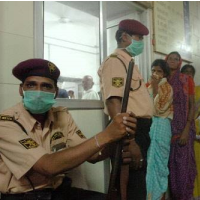Swine Flu May Be Mutating in India and Becoming More Infectious
 More than 25,000 people have already been infected in India (file photo)
More than 25,000 people have already been infected in India (file photo)
The swine flu outbreak in India that has already killed more than 1,400 people since December may be even more dangerous than previously thought, with a new U.S. study suggesting that strain of H1N1 virus in India has mutated to become more virulent. But the Health Ministry has disputed these findings, saying the study is based on old data that is not relevant to India.
The study, conducted by two researchers from the Massachusetts Institute of Technology (MIT) and reported in Science Daily, said that the genetic information of two Indian strains, deposited in public databases in the past two years, revealed new mutations that could make the virus more deadly.
Researchers Ram Sasisekharan and Kannan Tharakaraman compared the two influenza strains currently affecting the Indian population with the 2009 strain of H1N1 using their respective genetic sequences. They found mutations in the Indian strains in a protein called hemagglutinin, which binds with receptors on the human body’s respiratory cells. One of the mutations is linked to increased severity of the disease, while another enhances its infectiousness.
“The point we’re trying to make is that there is a real need for aggressive surveillance to ensure that the anxiety and hysteria are brought down and people are able to focus on what they really need to worry about,” said Sasisekharan.
But India's National Institute of Virology said in a statement late on Thursday that the findings were "incorrect".
"We found that the strain analysed in the said publication and the sequence data of the original H1N1 virus ... did not show any of these mutations," the institute said.
The government agency also said the strain analysed by the U.S. scientists had no relevance to the current outbreak.
“The virus has not undergone any major mutation so as to make it more virulent and nor has the H1N1 virus become resistant to the mainline drug Tamiflu,” the Health Ministry said in a statement.
According to Reuters, some other experts have also contested the findings.
"There should be increased surveillance for influenza in India but at the same time we should not draw conclusions based on the sequence analysis of two strains," said Manish Kakkar of the Public Health Foundation of India.
But Quartz reported that Om Jaslok, director of the infectious diseases department at Jaslok Hospital in Mumbai, has found that swine-flu patients today need to be treated with anti-viral drugs for twice the number of days compared to previous outbreaks. This could imply that the virus has evolved to become harder to treat.
The MIT researchers, meanwhile, called for greater surveillance to determine whether the mutations were currently present in India.
In recent weeks, India has placed orders to increase the stock of diagnostic kits and procured additional doses of anti-viral drug Oseltamivir.
- Karan Singh
To Learn More:
India, U.S. researchers clash over swine flu strain mutation (by Aditya Kalra, Reuters)
India’s Swine Flu Virus Is Becoming More Severe and Infectious, Study Says (by Rishi Iyengar, Time)
While India ignores its swine-flu epidemic, the virus may have become deadlier (by Manu Balachandran, Quartz India)
Politicians Clueless as Swine Flu Death Toll Rises (by Karan Singh, AllGov India)
- Top Stories
- Controversies
- Where is the Money Going?
- India and the World
- Appointments and Resignations
- Unusual News
- Latest News
- India College Chain’s Expansion into U.S. Draws Opposition from Massachusetts Officials over Quality of Education
- Milk Shortages in India Tied to Release of New Movies Featuring Nation’s Favorite Stars
- Confusion Swirls around Kashmir Newspaper Ban in Wake of Violent Street Protests
- Polio-Free for 5 Years, India Launches Vaccine Drive after Polio Strain Discovery
- New Aviation Policy Could Increase Service, Lower Ticket Prices






Comments